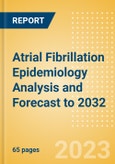Both men and women can have the disease. Major risk factors for AF are advancing age, hypertension, obesity, chronic diseases such as diabetes, heart failure, ischemic heart disease, hyperthyroidism, chronic kidney disease (CKD), alcohol intake, smoking, and enlargement of the chambers on the left side of the heart (Mayo Clinic, 2021b; Centers for Disease Control and Prevention, 2022; American Heart Association, 2023d). There is no cure for AF, however treatment and lifestyle changes can reduce symptoms, abnormal heart rhythms and prevent complications.
In the 8MM, total prevalent cases of AF are expected to increase from 14,457,906 cases in 2022 to 17,515,229 cases in 2032, at an annual growth rate (AGR) of 2.11%. In 2032, the US will have the highest number of total prevalent cases of AF in the 8MM, with 7,038,607 cases, whereas Canada will have the fewest total prevalent cases of AF with 712,577 cases. In the 8MM, diagnosed prevalent cases of AF are expected to increase from 12,862,824 cases in 2022 to 15,640,567 cases in 2032, at an annual growth rate (AGR) of 2.16%. In 2032, the US will have the highest number of diagnosed prevalent cases of AF in the 8MM, with 6,411,373 cases, whereas Canada will have the fewest diagnosed prevalent cases of AF with 649,076 cases. The publisher epidemiologists attribute the increase in the total and diagnosed prevalent cases of AF to changes in population dynamics and the diagnosis rate in each market.
Scope
- This report provides an overview of the risk factors, comorbidities, and the global and historical epidemiological trends for AF in the eight major markets (8MM: US, France, Germany, Italy, Spain, UK, Japan, and Canada). The report includes a 10-year epidemiology forecast for the total prevalent cases and diagnosed prevalent cases of AF. The total prevalent cases and the diagnosed prevalent cases of AF are segmented by age (40-49 years, 50-59 years, 60-69 years, 70-79 years, and 80 years and above) and sex. The report also includes the diagnosed prevalent cases of AF by temporal pattern of arrhythmia (paroxysmal, persistent, and permanent) and by stroke risk score based on CHADS2 score, and CHA2DS2-VASc score by sex. Diagnosed prevalent cases of AF are further segmented based on presence or absence of moderate-to-severe mitral stenosis and/or an artificial (mechanical) heart valve, and stages of CKD. Additionally, diagnosed prevalent cases of AF are segmented based on major bleeding risk by HAS-BLED score (low risk = 0, moderate risk = 1-2, and high risk = =3) and diagnosed prevalent cases of AF admitted to ED. This epidemiology forecast for AF is supported by data obtained from peer-reviewed articles and population-based studies. The forecast methodology was kept consistent across the 8MM to allow for a meaningful comparison of the forecast total prevalent cases and diagnosed prevalent cases of AF across these markets
Reasons to Buy
The atrial fibrillation epidemiology series will allow you to::
- Develop business strategies by understanding the trends shaping and driving the global atrial fibrillation market
- Quantify patient populations in the global atrial fibrillation market to improve product design, pricing, and launch plans
- Organize sales and marketing efforts by identifying the age groups that present the best opportunities for atrial fibrillation therapeutics in each of the markets covered.








